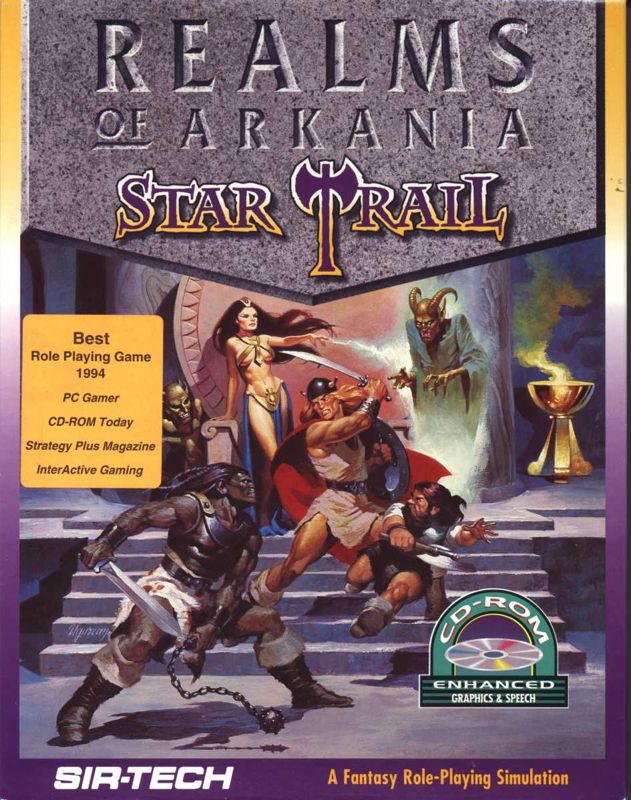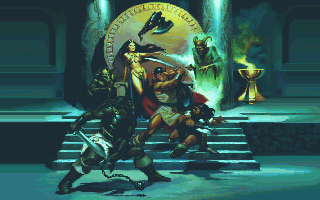Retro Replay Review
Gameplay
Realms of Arkania: Star Trail builds on the robust mechanics of its predecessor, delivering a deeply tactical role-playing experience rooted in the Das Schwarze Auge system. Character creation remains highly customizable, allowing players to fine-tune skills like Swordsmanship, Stealth, and Spellcasting. Each attribute and talent point investment has a meaningful impact on exploration and combat, encouraging thoughtful party composition before setting out on the road to Kvirasim.
Combat takes place on an isometric grid where positioning and terrain matter as much as statistics. Turning-based encounters require players to juggle weapon reach, spell area-of-effect, and defensive formations against goblins, undead dwarves, and—orc warbands. The interface offers detailed tactical options such as flanking bonuses, shield blocks, and weapon special attacks. While the learning curve can feel steep for newcomers, veterans of tabletop RPGs will appreciate the depth and the sense of accomplishment when a well-planned strategy pays off.
Beyond the main quest to recover the Salamander Stone and unite elves and dwarves, Star Trail features a wealth of side quests and random encounters. From rescuing stranded merchants to investigating haunted ruins, these detours add flavor and moral ambiguity, often forcing you to choose between gold, reputation, or even your companions’ demands. The game’s event engine responds to your decisions, shaping rival alliances and unlocking optional areas in the abandoned dwarven mine, so replayability is high for those eager to explore every branching path.
Graphics
In terms of visuals, Star Trail retains the pseudo-3D presentation that defined Blade of Destiny. Towns and wilderness areas scroll in smooth parallax layers, while dungeon walls and corridors use clever sprite scaling to simulate depth. Although the engine shows its age by modern standards, there’s a nostalgic charm to the hand-painted textures and the richly detailed environmental props—broken wagons, glowing mushrooms, and rune-inscribed pillars all contribute to a lived-in world.
Character and monster sprites are well-animated, especially during combat when warriors swing swords or mages unleash elemental blasts. The isometric battle screens are crisp and clear, with usable UI elements clustered at the bottom of the screen. Spell effects such as fireballs or healing lights stand out against darker backgrounds, making it easier to follow the action. The color palette strikes a balance between gritty realism and vibrant fantasy, ensuring that forests feel lush and dungeons foreboding.
One of the game’s graphical highlights is the variety of regional architecture. The port city of Kvirasim features winding wooden walkways and stilt-built homes, contrasting sharply with the stone-hewn entrances of the dwarven mine. Weather effects—drifting fog in swamps, drifting snow in mountain passes—add atmosphere, though they don’t dynamically change as you travel. Still, each locale has its own visual identity, reinforcing the sense that you’re traversing a living, breathing continent under siege by regrouped orc tribes.
Story
Star Trail picks up after the united orc tribes’ failed invasion of Thorwal, plunging your party into fresh intrigue when an elf ambassador in Kvirasim calls for your aid. The central plot revolves around the Salamander Stone, a legendary artifact believed capable of forging an alliance between elves and dwarves. On paper, the mission sounds straightforward: retrieve the stone from an abandoned dwarven mine and rally the kingdoms against a looming orc assault.
However, as you advance deeper into the mine and surrounding regions, it becomes clear that not everyone wishes to see elf and dwarf cooperation. Factions within both races view the union as a threat to their power, leading to sabotage attempts, political assassinations, and ancient grudges resurfacing in deadly ways. The narrative carefully unfolds through NPC dialogues, journal entries, and environmental storytelling, creating a tapestry of mistrust, heroism, and moral dilemma.
Side quests often tie back into these ethnic tensions, giving weight to every choice. Will you side with a secretive dwarven clan seeking vengeance, or aid an elven noble who believes in peaceful unity? Decisions you make can permanently close off diplomatic avenues or open hidden caches of lore. This layered storytelling, combined with the classic tabletop rulebook mindset, gives Star Trail a mature, complex narrative that rewards patience and exploration.
Overall Experience
Realms of Arkania: Star Trail delivers a rewarding blend of strategic combat, intricate character development, and a richly woven plot. It may challenge players with its old-school interface and steep learning curve, but those who invest time in mastering the rules will find a deeply satisfying role-playing experience. The game’s emphasis on player choice ensures that no two journeys feel identical, and a single playthrough can easily stretch beyond fifty hours if you pursue all side content.
While the graphics and sound design reflect mid-1990s technology, the immersive environments and haunting musical cues still resonate with fans of classic CRPGs. The interface can be a barrier for newcomers, yet detailed in-game help screens and an active online community provide ample guidance. Pacing can sometimes falter between major dungeons, but optional quests and random encounters help break up the travelogue and maintain engagement.
For players seeking a thoughtfully crafted, old-school RPG that challenges both tactical skill and moral judgment, Star Trail remains a standout title. Its rich lore, built on the esteemed Das Schwarze Auge rule set, provides depth and authenticity rarely found in modern genre entries. Whether you’re a series veteran or a newcomer curious about German-made role-playing games, Realms of Arkania: Star Trail offers an enduring adventure worth exploring.
 Retro Replay Retro Replay gaming reviews, news, emulation, geek stuff and more!
Retro Replay Retro Replay gaming reviews, news, emulation, geek stuff and more!









Reviews
There are no reviews yet.